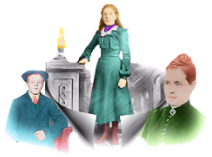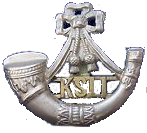


Kings Shropshire Light Infantry
1950-51
|
Hong Kong page 296 General Sir Robert Mansergh, KBE, CB, MC, when he arrived in October to take up his appointment as Commander of the Land Forces in Hong Kong. Captain Delme-Murray was its Commander, and the General wrote to express his pleasure, and to say how impressed he was by the excellent standard of turn-out and steadiness. 1950 A permanent Camp was being constructed at Sek Kong, growing up among the paddy fields, and the Battalion began to look upon it as its own possession. But when it was completed it was handed over to a Tank Battalion, and the KSLI was ordered to occupy a Camp at San Wai. At any rate this was better than the old tented Camp. It did consist of wooden huts, even though these had stood condemned as long ago as 1918, and as it was perched on the side of a hill facing south-east it caught any breeze there was, and was much cooler than Sek Kong. It was also quite close to the railway station of Fanling, which made Hong Kong much more easily accessible. In the autumn the war started in Korea, and two Battalions of the 27th Infantry Brigade with its HQ left for this new front almost immediately. As the chances of a speedy end to the war began to recede it became clear that further reinforcements would be required from the Hong Kong Division. The tempo of the training increased considerably, but the preliminary orders for the Battalion at first anticipated a move to Penang in Malaya. However these orders were cancelled in April and it began to prepare for active service in Korea. 1951 The Battalion was lucky to have had these eighteen months of training in Hong Kong, where the conditions were very similar. On arrival in Korea many of the circumstances were found to be most unusual, and there was much to be learnt about the very mobile form of warfare which was taking place there. But the sound basic training and the supreme fitness of the Battalion, combined with the very happy corporate spirit that had grown up, certainly gave it a flying start. In Korea The Advance Party, commanded by Major Thursby, and consisting of three Officers and forty Other Ranks sailed on April 19th on the USN. APA. “Montrose”. They joined the 1st Middlesex at Inchon on the 27th, and they remained there gathering information and preparing to take over drafts and stores, until the arrival of the main party. The Middlesex gave them first class hospitality, and were helpful in every way. The Battalion's own journey was postponed by another typhoon, but the voyage was remarkably comfortable, and Inchon was reached on May 13th. The ship's team had been well beaten in a boxing match, and the Officers, to the astonishment of all, had drunk the Wardroom in this 'dry' ship out of coffee! The 'Montrose' was ordered to practice assault landings, so the troops were unable to use the LST's for disembarkation, and had to manage with the ship's own landing craft. The concentration area was alongside the Middlesex Camp in a bend of the River Han, and a hectic evening was spent in handing over stores, and accepting and reorganising the reinforcements. The lay-out of the encampment astounded the War veterans. Everything was arranged in straight lines with no attempt at concealment from air or ground attack, just as though it was occupied by the TA in peaceful Wales, whereas it was only a mile or two behind the front line. This freedom from any threat of air observation remained throughout the campaign, though there was going to be plenty of trouble on the ground.
|
|
Korea page 297 The Battalion now found itself part of the 28th Commonwealth Infantry Brigade, commanded by Brigadier G. Taylor, DSO. It was a wonderfully mixed collection of troops, including Australians, Canadians, New Zealanders and Indians, as well as Americans and British. It was attached to the 24th US Infantry Division, and when the Battalion joined it was in Reserve. Yet there was a complete spirit of mutual co-operation among All Ranks, in spite of the doubt which did exist as to the exact object for which they were fighting. There were few similarities with modern warfare. Perhaps a combination of Italy in 1944 and the North West Frontier in 1930 would produce the best answer. The roads were dusty or muddy, and often very steep; always ahead there was a continuous panorama of black and formidable looking mountains up which supplies had somehow to be taken; and all the time the life of the Koreans went on, apparently impervious to the devastation of battle. Between May 15th and 19th the Battalion occupied a number of defensive positions without making any contact with the enemy. At the same time patrols were going out daily at Company, and once even at Battalion, strength, and they had small brisk fights with the enemy. On May 18th 'C' Company under Major Evans formed the Infantry element of one of these task forces, which had to ascertain whether Kumgong-Ni was occupied. It was Protecting the right flank, and had a grand stand view of the enemy attacking the tanks with sticky bombs and climbing all over them. The tanks opened fire on everything they could see, including the Company, but there were no casualties, and one prisoner was picked up during the advance. After a Brigade Conference on May 19th the Battalion was ordered to take part in its first set-piece attack since arriving in Korea. It was to be the spearhead of a general offensive by the 8th Army. Its objective was given as Pt.486, and 'A' and 'D' were the Assault Companies, with 'B' in Reserve and 'C' guarding the left flank. The attack began at 07.00 hours and by 08.00 hours the objective was captured after the Reserve Company had been called up to give assistance. A Platoon under Sergeant Rudd had cleared the last of the enemy defenders in a short and spirited action. The position had been held in strength, and the Battalion had been fortunate to capture it at the cost of two men killed and eleven wounded. [Researched comment: At the time it would appear that only officers are ever named when wounded or Killed. Casualties were as follows : L/Corporal's George Yapp and William Hanlon both Killed in Action and the 11 men wounded. - Lance Corporal. F. Bayley, Private R.K. Brown, Private T. Bagnall, Private W.T. Bames (Middlesex attached K.S.L.I.), Corporal R.W. Griffiths, Private R.S. Gordon, Private J.D. Garman (R. Sussex attached K.S.L.I.), Private S.G. Patworth, Private T. Sheldrake, Private HR. Seabright, Private H.W. Sellens (Middlesex attached K.S.L.I.)Private E.G. Stone, Private R. Smith. .
What is so tragic about this battle is that it was fought with no communications with command and the wounded men were laid out on stretchers for many hours awaiting casevac to medical care and Bob Griffiths was laid next to George and he confirmed that George died many hours before the helicopters could evacuate the wounded, Our family was informed that George died in the helicopter on the way to medical aid this I now know was nonsense, I certainly don't know if George would have lived if he had got help earlier...we will never know. [Please note webmasters comment ] Comment end. Gaps had been made all along the front and on the 21st May 1951 the Battalion was ordered to push on across the main road and to occupy Pt. 358. By 16.30 hours this had been accomplished in spite of a tremendous cloud burst, but communication with Brigade HQ, had broken down, and for a time it seemed to be cut off in a very damp and isolated position. However liaison was eventually effected on the afternoon of the 22nd May and the next day pts. 672 and 444 were also captured, and it was clear that strong enemy forces had only just withdrawn. This was confirmed by the vast quantities of small arms, pack saddlery and personal clothing left behind. That evening main HQ with 'A' and 'D' Companies arrived at Kagon-Ni with orders to capture Pts.639 and 388 the next morning. The CO brought down his tactical HQ with 'B'and 'C' Companies to join them at Pigum-Ni, and this was done so successfully that all objectives were taken with no casualties by the afternoon of the 24th May 1951. This brought the great May offensive to an end, but for a time there was uncertainty while the 8th Army considered the best way to exploit its advantage. Eventually on the 29th May 1951 the Battalion was ordered to the west to come under command of 1 (US) Corps North of Seoul, and in this sector it was to spend the rest of its time in Korea The excerpt above is courtesy of the Shropshire Regimental Museum for which I am truly grateful. © Shropshire Regimental Museum 1950 |


| About us |
| Contact us |
| our policy |
| Viewing Notes |
| Acknowledgements |
| Yapp family |
| james Yapps Cockney history |
| William and Eliza |
| Hannah and Mathew |
| James William Yapp |
| Mathew and Alice |
| Aussie connection |
| Family not forgotten |
| Origination 1 |
| Origination 2 |
| Origination 3 |
| KSLI 1951 |
| KSLI journal |
| Journal pt.1 |
| Journal pt.2 |
| Bill Griffiths |
| LCpl Hanlon |
| Bob_West |
| KSLI Roll of Honour |
| News Clips |
| Military Career |
| George Yapp KIA Korea |
| George service pictures |
| Communications |
| Georges Letters 1 |
| Georges letters 2 |
| Last letters home |
| Georges Awards |
| UN Memorial Cemetery Korea |
| Georges Story |
| Exchange rates |
| World Time |
| Speed Tester |